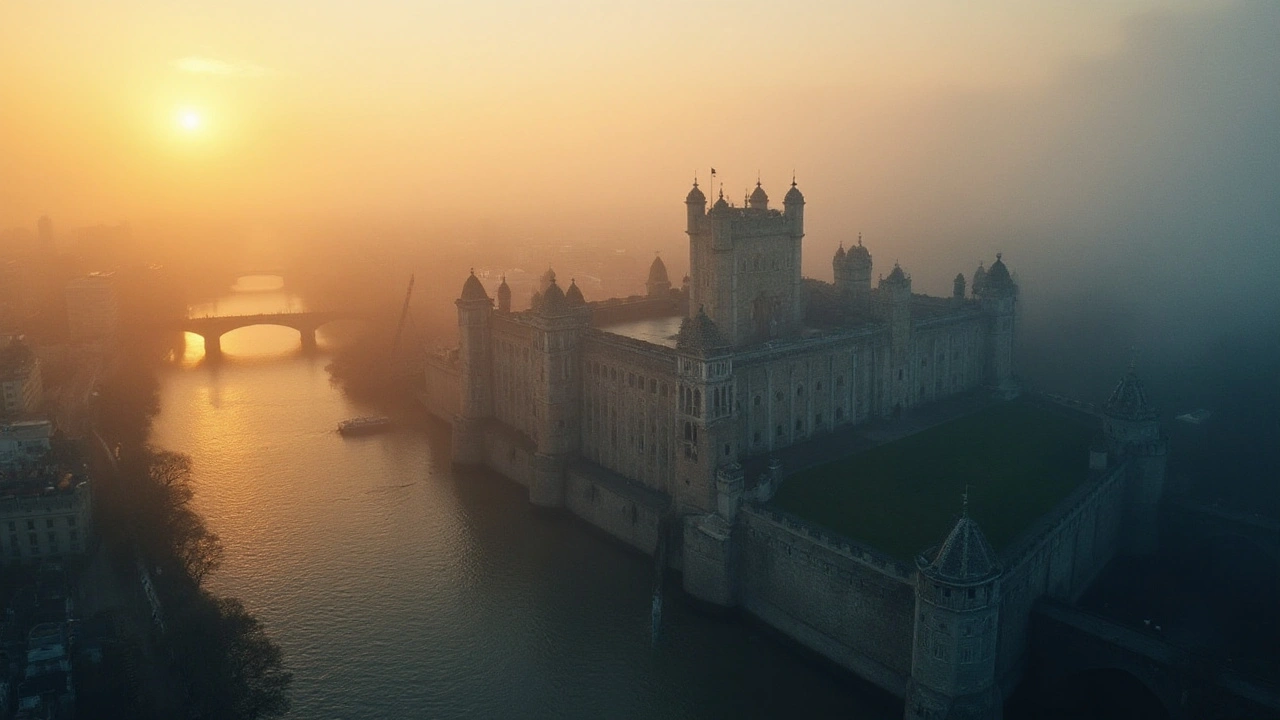Must-See Landmarks: From the Pyramids to the Eiffel Tower - London’s Top Global Icons
When you live in London, you’re surrounded by history every day. The Tower Bridge, Big Ben, and the London Eye aren’t just postcard views-they’re part of your commute, your weekend walks, your lunch breaks. But have you ever stopped to think how rare it is to live in a city that’s also a global landmark itself? While you’ve seen the Thames at sunrise and queued for the Tube at peak hour, millions around the world are saving up for flights to see what you walk past without a second thought. That’s why, when you’re planning your next trip abroad, it helps to know which landmarks truly matter-and why they’re worth the journey.
Why the Pyramids Still Command Respect
The Great Pyramid of Giza isn’t just old-it’s the only surviving wonder of the ancient world. Built over 4,500 years ago, it stood as the tallest human-made structure for nearly 4,000 years. That’s longer than the time between the Roman Empire and today. Unlike London’s medieval castles, which were rebuilt and expanded, the Pyramids were built to last exactly as they were: a statement of power, precision, and belief in the afterlife. No mortar was used. The stones fit so tightly, you can’t slide a credit card between them. And they were moved without wheels or cranes.
Most tourists in Cairo stick to the main site, but locals know the best views come from the desert edge near the Sphinx, just before sunset. The light turns the sand gold, and the pyramid’s shadow stretches across the plateau like a giant sundial. If you’re flying from Heathrow, Emirates and EgyptAir both offer direct flights. Book early-November is peak season, and prices spike fast.
The Eiffel Tower: More Than a Paris Postcard
People think of the Eiffel Tower as romantic. They’re right. But they forget it was almost torn down. Built for the 1889 World’s Fair, it was mocked as an eyesore by Parisian artists and writers. Today, it’s the most visited paid monument on Earth. Over 6 million people climb it each year. And here’s what most don’t know: the iron expands in summer heat, making the tower grow up to 15 cm taller. That’s why the top floor, which you can only reach by elevator, feels different depending on the season.
If you’re visiting from London, take the Eurostar. It’s faster than flying when you factor in airport security and transit. Once there, skip the main entrance line by booking a timed ticket online. The second floor offers the best photo angle of the Seine and the Louvre. And if you’re feeling adventurous, climb the 674 steps to the second level-it’s free with your ticket, and you’ll have the view to yourself before the crowds arrive.
London’s Own Landmarks: The Ones You’ve Forgotten
While you’re planning trips to Cairo and Paris, don’t forget what’s right here. Stonehenge is just a 90-minute train ride from Waterloo. The stones, aligned with the solstice sun, are older than the Pyramids. And unlike the crowds at Giza, you can walk right up to them-no barriers, no ticket lines on weekdays.
Then there’s Hadrian’s Wall. Stretching 73 miles across northern England, it was built by Roman soldiers to keep out the tribes of Scotland. Walk a stretch near Housesteads Fort, and you’ll see the original milecastles, latrines, and barracks still standing. It’s not flashy like the Eiffel Tower, but it’s real. You’re standing where a Roman centurion once drank his wine and watched the clouds roll in.
And let’s not forget the London Eye. It opened in 2000, and now it’s as much a part of the skyline as Big Ben. Ride it at dusk, when the city lights come on and the Thames glows like liquid mercury. You’ll see the Houses of Parliament, Westminster Abbey, and the Shard-all from 135 meters up. It’s not ancient, but it’s the perfect symbol of modern London: bold, engineered, and unforgettable.
What Makes a Landmark Last?
Not all old things become landmarks. The Colosseum survived because Romans kept using it-first as a quarry, then as a fortress, then as a church. The Taj Mahal endured because it was never just a tomb; it became a symbol of love that transcended politics. The Pyramids? They survived because they were built to be impossible to destroy.
London’s landmarks follow the same pattern. Tower Bridge isn’t just a bridge-it’s a working marvel. Every day, its bascules lift for ships. The Royal Observatory in Greenwich? It’s where time itself was defined. The Prime Meridian runs right through its courtyard. That’s why your phone knows the exact time-it’s synced to a clock in London.
What separates a landmark from a building? It’s not age. It’s meaning. It’s the stories people tell about it. The story of the Eiffel Tower isn’t just about iron-it’s about defiance. The story of the Pyramids isn’t about stone-it’s about eternity. And the story of London? It’s about resilience. You’ve seen the city survive fires, plagues, bombs, and Brexit. That’s why your favorite pub on Camden High Street, your weekend market in Spitalfields, your quiet walk along the South Bank-they’re all part of the same legacy.
How to Plan Your Next Trip Like a Local
If you’re thinking of visiting one of these landmarks, here’s how to do it right:
- Book ahead-even for free sites like Stonehenge. Crowds are worse than you think.
- Travel off-season-November and February are quiet in Paris and Cairo. You’ll get better prices and real space to absorb the place.
- Stay local-skip the chain hotels. In Paris, try a small guesthouse in Montmartre. In Cairo, book a Nile-view apartment in Zamalek. You’ll eat better, sleep quieter, and feel like you’re living there, not just visiting.
- Bring a good camera-but leave the selfie stick at home. The best photos come from patience, not posing.
- Learn one phrase-"Merci" in Paris, "Shukran" in Cairo, "Thank you" in London. It changes how people treat you.
And if you’re short on time? Start with the London Eye. Then go to the British Museum. Then walk to the Tate Modern. You’ve just covered 5,000 years of human history in a single afternoon. That’s the power of living here.
Landmarks Are About More Than Sightseeing
The Pyramids don’t exist to be climbed. The Eiffel Tower isn’t just a tower. And Tower Bridge isn’t just a bridge. They’re all anchors-places that hold time still. When you stand in front of them, you’re not just looking at stone or steel. You’re touching something that outlasted empires, wars, and revolutions.
And here’s the quiet truth: the most powerful landmark isn’t in Egypt or France. It’s the one you pass every day on your way to work. The red phone box. The black cab. The pub with the same landlord since 1978. These are your landmarks. They don’t make the travel magazines. But they’re the ones that will outlive them all.
What’s the best way to visit the Pyramids from London?
Fly direct from Heathrow with Emirates or EgyptAir. Book a morning flight to arrive by lunchtime. Stay overnight in a Nile-view hotel in Zamalek to avoid the midday heat and crowds. Visit the Pyramids early the next day-sunrise is the best time for photos and quiet.
Is the Eiffel Tower worth visiting if I’ve seen it in pictures?
Yes. Photos don’t capture the scale. The ironwork hums in the wind. The view from the second floor shows how Paris is built in layers-medieval streets, Haussmann boulevards, modern towers. And the way the light hits the tower at golden hour? No filter can replicate that. Book a timed ticket online to skip the line and go at sunset.
Are there any UK landmarks as impressive as the Pyramids or Eiffel Tower?
Absolutely. Stonehenge is older than the Pyramids. Hadrian’s Wall stretches across the countryside like a forgotten dragon. The Tower of London has held kings, queens, and treason. And the London Eye? It’s the only landmark built in your lifetime that’s already iconic. These places don’t need flashy marketing-they’ve earned their place through history, engineering, and endurance.
How do I avoid tourist traps when visiting global landmarks?
Skip the packaged tours. Book tickets directly through official websites. Eat where locals eat-look for places with no English menus and a line of locals outside. In Paris, avoid restaurants near the Eiffel Tower’s base. Walk 10 minutes to Rue de la Tour Maubourg. In Cairo, skip the camel rides near the Pyramids-head to the desert edge instead. And in London? Skip the Big Ben photo spots on the Westminster side. Walk to Vauxhall Bridge for a cleaner, quieter view.
What’s the best time of year to visit these landmarks?
November through February is ideal. Crowds drop, prices fall, and the light is softer. In Cairo, it’s cooler. In Paris, the city feels more intimate. In London, you’ll have the South Bank to yourself. Plus, you’ll avoid the summer heat and the school holiday chaos. Pack layers-European weather changes fast.
If you’ve ever stood on the South Bank watching the sun set behind the Shard, you already know what makes a landmark unforgettable. It’s not the size. It’s the silence that follows when you realize you’re standing where history happened. And that’s something no postcard can ever capture.


